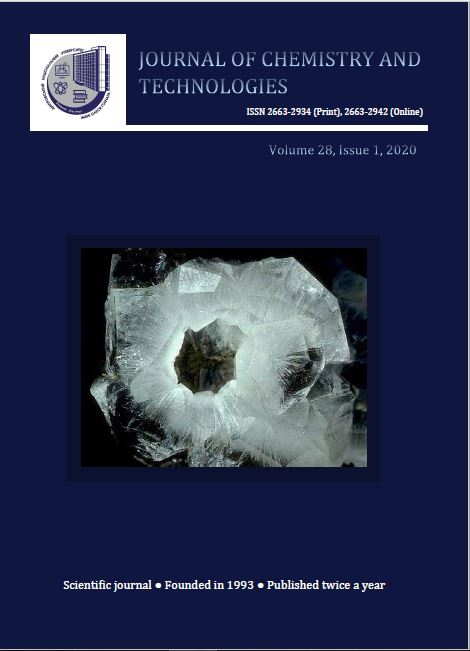ELECTRODEPOSITION OF COPPER FROM A METHANESULPHONATE ELECTROLYTE
DOI:
https://doi.org/10.15421/082001Keywords:
еlectrodeposition, methanesulfonate electrolyte, copper, electrical conductivity, physical and mechanical properties, morphology, structureAbstract
The dependences of the electrical conductivity of the methanesulfonate copper plating electrolyte on the concentrations of acid and copper methanesulfonate have been established. It has been shown that an electrolyte with a composition of 0.6 M Cu (CH3SO3)2 + 0.6 M CH3SO3Н is characterized by maximum copper ion concentration and high electrical conductivity. The study of the morphology of the copper coatings obtained in different hydrodynamic modes showed that smooth fine-grained deposits, well adhered to the base can be obtained from stirred methanesulfonate electrolyte in a range of current densities of 1 to 7 A/dm2.
High-quality deposits from a quiescent electrolyte are obtained at current densities below 3 A/dm2.X-ray analysis of copper coatings deposited from a methanesulfonate electrolyte showed that their structure corresponds to a face-centred cubic lattice. The deposit crystallite sizes decrease with increasing the current density. The dependence of the dislocation density on the current density is antibate. Stirring of the electrolyte mitigates the impact of current density on the parameters of the structure of coating , which changes are significantly reduced. It has been shown that stirring the electrolyte affects the structurally dependent properties of the copper coatings, such as internal stress and micro hardness. Along with the diminishing crystallite sizes, an increase in the internal stress and micro hardness of the coatings is observed. Stirring, along with the expansion of the range of coating current densities can reduce the internal stress of the ones. This is an important factor for obtaining thick layers of copper.References
Abdel Rahman, H.H., Moustafa, A.H.E. Abdel Magid, S.M.K. (2012). High Rate Copper Electrodeposition in the Presence of Inorganic Salts. International Journal of Electrochemical Science , 7, 6959 – 6975.
Sankar, P. Ram., Khattak, B. Q. Jain, A. K., Kaul, R., Ganesh, P., Nath, A. K., Tiwari, P., Amban, A., Pagare, A. (2005). Electroforming of copper by the periodic reversal process. Surface Engineering. 21(3), 204–208.
Pasquale, M.A., Gassa, L.M., Arvia, A.J. (2008). Copper electrodeposition from an acidic plating bath containing accelerating and inhibiting organic additives. Electrochimica Acta, 53, 5891–5904.
Kazuo Kondo, Rohan N. Akolkar, Dale P. Barkey, Masayuki Yokoi. (Eds.). (2014). Copper Electrodeposition for Nanofabrication of Electronics Devices. Vol. 171. Lockwood, Ottawa, Canada: Nanostructure Science and Technology .
Mathur, Jaishree, Gupta, Manish. (2013). Effect of Electrodeposition Parameters on Morphology of Copper Thin Films. IOSR Journal of Engineering, 3(8), 55–61.
Bicelli, Luisa Peraldo, Bozzini, Benedetto, Mele, Claudio, D'Urzo, Lucia. (2008). A Review of Nanostructural Aspects of Metal Electrodeposition, International Journal of Electrochemical Science, 3, 356–408.
Milchev, A. (2002). Electrocrystallization: Fundamentals of Nucleation and Growth, Dordrecht, Kluwer Academic Publishers.
Sknar, I., Petrenko, L., Cheremysinova, A., Plyasovskaya, K., Kozlov, Ya., Amirulloyeva, N. (2017). Investigation of adsorption behavior of smoothing additives in copper plating electrolytes. Eastern-European Journal of Enterprise Technologies, 2(11-86), 43–49.
Beukes, N.T., Badenhorst, J. (2009). Copper electrowinning: theoretical and practical design. Journal of the Southern African Institute of Mining and Metallurgy , 109, 343–356.
Hasan, M., Casey, D. and Rohan, J. (2009). Electrochemical Properties of Cu Deposition from Methanesulphonate Electrolytes for ULSI and MEMS Applications. ECS Transactions, 19(24), 57–66. http://dx.doi.org/10.1149/1.3246598
Sekar R., Jayakrishnan S. (2012). Effect of sulphonic acids on electrodeposition of nickel and its structural and corrosion behaviour. Transactions of the Institute of Metal Finishing, 90, 324–329.
Sknar, Yu. E., Amirulloeva, N. V., Sknar, I. V., Danylov, F. I. (2016). Influence of methylsulfonate anions on the structure of electrolytic cobalt coatings. Materials Science, 52(3), 396–401.
https://doi.org/10.1007/s11003-016-9970-9.
Sknar, Y., Sknar, I., Cheremysinova, A., Yermolenko, I., Karakurkchi, A., Mizin, V., Proskurina, V., Sachanova, Y. (2017). Research into composition and properties of the Ni-Fe electrolytic alloy. Eastern-European Journal of Enterprise Technologies, 4(12-88), 4–10.
Savchuk, O., Sknar, Y., Sknar, I., Cheremysinova, A., Kozlov, Y. (2017). Examining the effect of electrosynthesis conditions on the Ni-P alloy composition. Eastern-European Journal of Enterprise Technologies, 4(6-88), 41-46.
Sknar, Yu. E., Amirulloeva, N. V., Sknar, I. V., Danylov, F. I. (2016). Electrodeposition of Ni–ZrO2 Nanocomposites from Methanesulfonate Electrolytes. Materials Science, 51(6), 877–884. https://doi.org/10.1007/s11003-016-9916-2.
Danilov, F. I., Sknar, Yu. E., Tkach, I. G., Sknar, I. V. (2015). Electrodeposition of Nickel Based Nanocomposite Coatings from Cerium(III)–Ion Containing Methanesulfonate Electrolytes. Russian Journal of Electrochemistry, 51(4), 294–298. https://doi.org/10.1134/S1023193515040023.
Hasan, M., Casey, Declan P., Rohan, James F. (2009). Electrochemical Properties of Cu Deposition from Methanesulphonate Electrolytes for ULSI and MEMS Applications. ECS Transactions, 19(24), 57–66.
Hasan, M., Rohan. James F. (2010). Cu Electrodeposition from Methanesulfonate Electrolytes for ULSI and MEMS Applications. Journal of The Electrochemical Society, 157 (5), D278-D282.
Florence, F., Nisha, Susai Rajendran, Srinivasan, K.N., John, S. (2011). Studies on Electrodeposition of Copper from Methanesulphonic Acid Bath. International Journal of ChemTech Research CODEN( USA), 3(3), 1318–1325.
Gernon, M. D., Wu, M., Buszta, T., Janney, P. (1999). Environmental benefits of methanesulfonic acid: Comparative properties and advantages. Green Chemistry, 1, 127 – 140
Mirkin, L. I. (1961). [Spravochnik po rentgenostrukturnomu analizu polikristallov]. Moskow, USSR: Fizmatlit. (in Russian).
Downloads
Published
Issue
Section
License
Copyright (c) 2020 Днипровский национальный университет имени Олеся Гончара

This work is licensed under a Creative Commons Attribution 4.0 International License.
- Authors reserve the right of attribution for the submitted manuscript, while transferring to the Journal the right to publish the article under the Creative Commons Attribution License. This license allows free distribution of the published work under the condition of proper attribution of the original authors and the initial publication source (i.e. the Journal)
- Authors have the right to enter into separate agreements for additional non-exclusive distribution of the work in the form it was published in the Journal (such as publishing the article on the institutional website or as a part of a monograph), provided the original publication in this Journal is properly referenced
- The Journal allows and encourages online publication of the manuscripts (such as on personal web pages), even when such a manuscript is still under editorial consideration, since it allows for a productive scientific discussion and better citation dynamics (see The Effect of Open Access).


